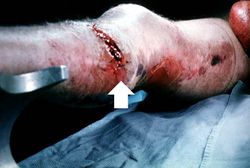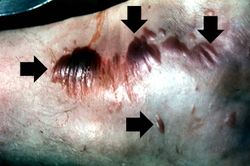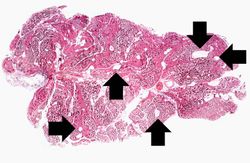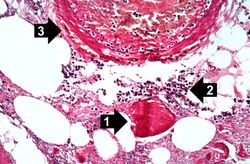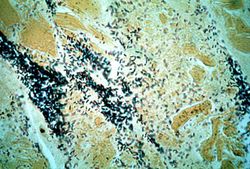Difference between revisions of "IPLab:Lab 9:Clostridial Myonecrosis"
Seung Park (talk | contribs) (→Related IPLab Cases) |
Seung Park (talk | contribs) |
||
| (2 intermediate revisions by the same user not shown) | |||
| Line 1: | Line 1: | ||
== Clinical Summary == | == Clinical Summary == | ||
| − | This 68-year-old white male with insulin-dependent diabetes was admitted one day before his death. The chief complaints were the occurrence of chills and fever since passing a kidney stone two days earlier. In the last day, the right leg had become swollen. The most striking physical findings were redness of the right posterior calf and crepitance in both legs. The patient's white blood cell count was found to be 34,000 cells/ | + | This 68-year-old white male with insulin-dependent diabetes was admitted one day before his death. The chief complaints were the occurrence of chills and fever since passing a kidney stone two days earlier. In the last day, the right leg had become swollen. The most striking physical findings were redness of the right posterior calf and crepitance in both legs. The patient's white blood cell count was found to be 34,000 cells/mm³ and the packed red blood cell volume (PCV) was 18%. Within hours, the right calf became tense and the crepitance spread up to the nipple line. The patient vomited, aspirated the vomitus, and died 10 hours after admission. |
== Images == | == Images == | ||
| Line 12: | Line 12: | ||
File:IPLab9Clostridium7.jpg|This is a high-power photomicrograph of a tissue section stained with a tissue Gram's stain (Brown & Brenn). The Gram-positive bacilli can be seen throughout this tissue section. | File:IPLab9Clostridium7.jpg|This is a high-power photomicrograph of a tissue section stained with a tissue Gram's stain (Brown & Brenn). The Gram-positive bacilli can be seen throughout this tissue section. | ||
</gallery> | </gallery> | ||
| + | |||
| + | == Virtual Microscopy == | ||
| + | <peir-vm>IPLab9Clostridium</peir-vm> | ||
== Study Questions == | == Study Questions == | ||
| Line 30: | Line 33: | ||
=== Images === | === Images === | ||
| − | * [ | + | * [{{SERVER}}/library/index.php?/tags/167-clostridium_infection PEIR Digital Library: Clostridium Infection Images] |
* [http://library.med.utah.edu/WebPath/INFLHTML/INFLIDX.html WebPath: Inflammation] | * [http://library.med.utah.edu/WebPath/INFLHTML/INFLIDX.html WebPath: Inflammation] | ||
Latest revision as of 16:32, 3 January 2014
Contents
Clinical Summary[edit]
This 68-year-old white male with insulin-dependent diabetes was admitted one day before his death. The chief complaints were the occurrence of chills and fever since passing a kidney stone two days earlier. In the last day, the right leg had become swollen. The most striking physical findings were redness of the right posterior calf and crepitance in both legs. The patient's white blood cell count was found to be 34,000 cells/mm³ and the packed red blood cell volume (PCV) was 18%. Within hours, the right calf became tense and the crepitance spread up to the nipple line. The patient vomited, aspirated the vomitus, and died 10 hours after admission.
Images[edit]
This is a high-power photomicrograph of skeletal muscle. The muscle cells are hypereosinophilic and most do not contain nuclei, indicating that these cells are dead or dying. The round clear spaces (1) in this tissue correspond to gas accumulations prior to death. In between the bundles of muscle cells, accumulations of small dark blue-staining bacterial organisms can be seen (2). Also note that there is no inflammatory response in this tissue.
Virtual Microscopy[edit]
Study Questions[edit]
Additional Resources[edit]
Reference[edit]
- eMedicine Medical Library: Clostridial Gas Gangrene
- eMedicine Medical Library: Gas Gangrene
- Merck Manual: Gas Gangrene
Images[edit]
| |||||
A normal white blood cell count is 4,000 to 11,000 cells per cubic mm.
A normal hematocrit for a male is 39 to 49%.
